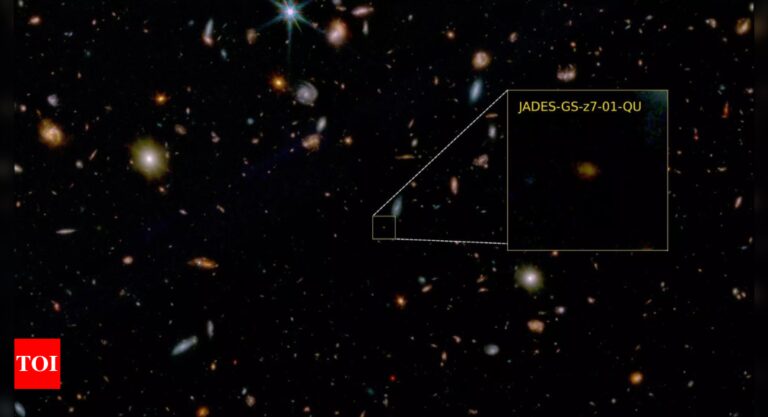
[ad_1]
NEW DELHI: The James Webb Space telescope detected a “dead” galaxy that ceased star formation when the universe was only 5% of its current age. The star formation ended approximately 13.1 billion years ago in the galaxy observed, just 700 million years after the Big Bang.
This discovery by Webb telescope, operational since 2022, marks the earliest-known instance of a “dead” galaxy, surpassing previous findings by about 500 million years.
Astrophysicist Tobias Looser from the Kavli Institute for Cosmology at the University of Cambridge, lead author of the study published in Nature, likened the galaxy to the late Hollywood actor James Dean, noting its fast-paced star formation followed by a sudden halt.
“The galaxy appeared to have undergone rapid star formation before abruptly ceasing,” said Looser. “During the universe’s early stages, abundant gas fueled galaxy formation, making this discovery particularly intriguing.”
This galaxy, estimated to contain between 100 million and one billion stars, is comparable in size to the Small Magellanic Cloud dwarf galaxy near the Milky Way. However, unlike the Small Magellanic Cloud, which continues to form new stars, this galaxy has entered a state of dormancy.
“After star formation ends, existing stars expire without replacement,” explained Kavli Institute astrophysicist Francesco D’Eugenio, a co-author of the study. “The galaxy’s color shifts from blue to yellow to red as it loses its most massive stars first.”
The researchers determined that the galaxy experienced a brief burst of star formation lasting between 30 to 90 million years before abruptly halting. They are currently investigating potential causes for this sudden cessation, including the influence of a supermassive black hole at the galaxy’s center or energy feedback from newly formed stars.
“Alternatively, star formation may have ceased due to a depletion of gas, either from rapid consumption or a lack of replenishment,” added Looser.
Nasa‘s Webb telescope, with its enhanced capability to observe distant objects, has provided astronomers with unprecedented views of the early universe. In this study, researchers observed the dead galaxy at a single moment in time, leaving open the possibility that it may have resumed star formation later.
(With Reuters inputs)
This discovery by Webb telescope, operational since 2022, marks the earliest-known instance of a “dead” galaxy, surpassing previous findings by about 500 million years.
Astrophysicist Tobias Looser from the Kavli Institute for Cosmology at the University of Cambridge, lead author of the study published in Nature, likened the galaxy to the late Hollywood actor James Dean, noting its fast-paced star formation followed by a sudden halt.
“The galaxy appeared to have undergone rapid star formation before abruptly ceasing,” said Looser. “During the universe’s early stages, abundant gas fueled galaxy formation, making this discovery particularly intriguing.”
This galaxy, estimated to contain between 100 million and one billion stars, is comparable in size to the Small Magellanic Cloud dwarf galaxy near the Milky Way. However, unlike the Small Magellanic Cloud, which continues to form new stars, this galaxy has entered a state of dormancy.
“After star formation ends, existing stars expire without replacement,” explained Kavli Institute astrophysicist Francesco D’Eugenio, a co-author of the study. “The galaxy’s color shifts from blue to yellow to red as it loses its most massive stars first.”
The researchers determined that the galaxy experienced a brief burst of star formation lasting between 30 to 90 million years before abruptly halting. They are currently investigating potential causes for this sudden cessation, including the influence of a supermassive black hole at the galaxy’s center or energy feedback from newly formed stars.
“Alternatively, star formation may have ceased due to a depletion of gas, either from rapid consumption or a lack of replenishment,” added Looser.
Nasa‘s Webb telescope, with its enhanced capability to observe distant objects, has provided astronomers with unprecedented views of the early universe. In this study, researchers observed the dead galaxy at a single moment in time, leaving open the possibility that it may have resumed star formation later.
(With Reuters inputs)
[ad_2]
